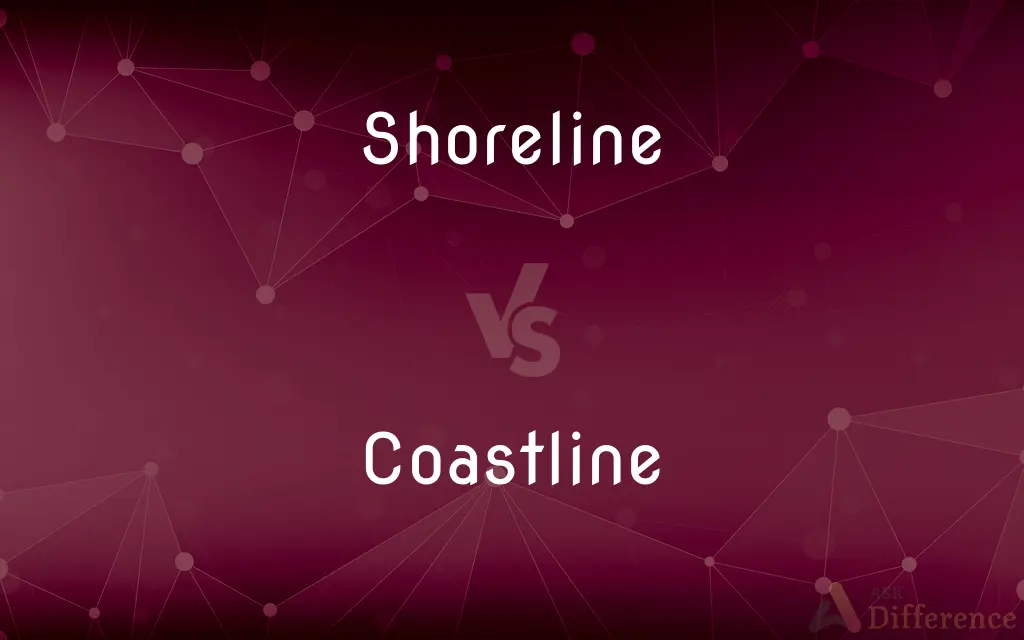Shoreline vs. Coastline — What's the Difference?
By Tayyaba Rehman & Urooj Arif — Updated on April 4, 2024
Shoreline refers to the area where land meets water, constantly changing with tides, while coastline represents the outer boundary of the land next to the sea, more fixed in mapping.

Difference Between Shoreline and Coastline
Table of Contents
ADVERTISEMENT
Key Differences
The shoreline is the area where land meets water, a boundary that is constantly changing with the rise and fall of tides. This makes it a dynamic and somewhat transient feature. Whereas the coastline, on the other hand, refers to the outer boundary of the land next to the sea or ocean, often considered from a mapping or geographical perspective. It's seen as more constant and is used for official mapping and descriptions of a country’s geographical boundary.
The shoreline encompasses both the high tide mark and the low tide mark, making its exact location variable throughout the day. It is directly affected by tidal movements, which can alter its appearance and even its ecosystem. On the other hand, the coastline is typically measured at a specific tidal condition, often the mean high water mark, which provides a more stable reference point for mapping and legal purposes.
Ecologically, the shoreline is a critical habitat that supports a diverse range of species adapted to its changing conditions. This area can include beaches, estuaries, and mangroves, each with unique ecosystems. Conversely, the coastline, while also ecologically significant, is more of a conceptual boundary used for broader geographical and ecological studies, rather than focusing on the dynamic interactions at the water’s edge.
In terms of human interaction, the shoreline is where most recreational activities such as swimming, boating, and fishing take place. It is accessible and often developed for tourism and leisure. The coastline, while it encompasses these areas, is more involved in territorial rights, navigation, and economic zones extending into the sea, thus playing a crucial role in maritime law and sovereignty.
The perception of the shoreline and coastline also differs in literature and art. The shoreline, with its ever-changing nature, symbolizes transition, boundaries, and the ephemeral aspects of nature. Meanwhile, the coastline often represents the edge of human exploration, a boundary between the known and the unknown, serving as a metaphor for discovery and the limits of human control.
ADVERTISEMENT
Comparison Chart
Definition
Area where land meets water, changing with tides.
Outer boundary of land next to sea, used in mapping.
Stability
Variable, changes with tides.
Relatively fixed, used for official boundaries.
Measurement
Between high and low tide marks.
Often at mean high water mark.
Ecological significance
Critical habitat for diverse species, dynamic.
Conceptual boundary for broader geographical studies.
Human interaction
Site of recreational activities, accessible.
Involved in territorial rights and maritime law.
Compare with Definitions
Shoreline
Recreational Space.
Families flock to the shoreline each summer to enjoy the sun and sea.
Coastline
Fixed in Maps.
Cartographers accurately depict the coastline in their detailed maps.
Shoreline
Affected by Tides.
The shoreline looks completely different at high tide compared to low tide.
Coastline
Unchanging Reference.
The coastline serves as a constant reference point for sailors navigating near land.
Shoreline
Ecosystem Hub.
The shoreline is bustling with life, from crabs scuttling to birds fishing.
Coastline
Metaphor for Exploration.
The coastline represents the edge of the known world in ancient maps.
Shoreline
Symbol in Literature.
The novel uses the shoreline as a metaphor for life's constant changes.
Coastline
Geographical Boundary.
The country's coastline stretches over thousands of kilometers.
Shoreline
Dynamic Boundary.
The shoreline shifted significantly after the storm, revealing new sandbars.
Coastline
Maritime Rights.
The nation's economic zone extends 200 nautical miles beyond its coastline.
Shoreline
The edge of a body of water.
Coastline
The shape, outline, or boundary of a coast.
Shoreline
The divide between land and a body of water.
Coastline
The shape, outline, or boundary of a coast. (The term coastline is generally used to describe the approximate boundaries at relatively large spatial scales.)
Shoreline
The line on a map that illustrates this.
Coastline
The outline of a coast
Shoreline
A boundary line between land and water
Common Curiosities
What is a coastline?
The outer boundary of the land next to the sea, used for mapping and official boundaries.
Can the shoreline's location change?
Yes, it varies with tidal movements and can change significantly over time.
What is a shoreline?
The area where land meets water, constantly changing with the tide.
How does the shoreline differ from the coastline?
The shoreline changes with tides, while the coastline is a fixed geographical boundary.
How do coastlines impact maritime law?
They define territorial waters and economic zones, impacting navigation and sovereignty.
Why is the coastline important for mapping?
It provides a stable reference for geographical boundaries and maritime rights.
Is the coastline affected by tides?
The coastline is measured at a specific tidal condition, so it remains relatively constant regardless of tidal changes.
Can the coastline change over time?
Yes, due to natural processes like erosion and sediment deposition, but these changes are typically gradual.
What role does the shoreline play in tourism?
It's a key attraction for tourists seeking beach activities and waterfront relaxation.
Why is the shoreline important ecologically?
It supports diverse species and ecosystems, adapting to its dynamic conditions.
How do tides affect the shoreline?
Tides alter the shoreline's appearance and accessibility, expanding and contracting its boundaries.
What human activities are common on the shoreline?
Recreational activities like swimming, boating, and fishing are prevalent.
What's the significance of the coastline in literature?
It often symbolizes the limits of human exploration and the boundary between the known and unknown.
How is the shoreline different from a beach?
The shoreline is the broad area where land meets water, while a beach specifically refers to sandy or pebbly shorelines.
Are shorelines and coastlines the same around the world?
No, their characteristics can vary greatly due to geographical, ecological, and tidal differences.
Share Your Discovery

Previous Comparison
Artifact vs. Fossil
Next Comparison
Excusable vs. InexcusableAuthor Spotlight
Written by
Tayyaba RehmanTayyaba Rehman is a distinguished writer, currently serving as a primary contributor to askdifference.com. As a researcher in semantics and etymology, Tayyaba's passion for the complexity of languages and their distinctions has found a perfect home on the platform. Tayyaba delves into the intricacies of language, distinguishing between commonly confused words and phrases, thereby providing clarity for readers worldwide.
Co-written by
Urooj ArifUrooj is a skilled content writer at Ask Difference, known for her exceptional ability to simplify complex topics into engaging and informative content. With a passion for research and a flair for clear, concise writing, she consistently delivers articles that resonate with our diverse audience.















































